A two seater sportster, not a truck.
Part I appears here.
My 11.6″, 2gB RAM, 32gB flash disk storage Mac Book Air arrived yesterday and I have spent a few hours wringing it out.
I am writing this on the MacBook Air (MBA).
First impressions:
The MBA is a masterpiece of machine craft. Despite incredible slimness at the thin edge of the wedge (!) it feels robust rather than fragile. The full size keyboard is worth the price differential over a cheap netbook alone. Too bad it’s not backlit like on its much heavier (4.5lbs and up) brother, the MacBook Pro. The machine is unbelievably light – no self respecting student will want to be without one of these.
The battery on mine was 80% charged on receipt and the Magsafe power connector can be connected either way, only one of the two ways possible clearing the left hand of the two USB sockets The finish is, for the most part, Leica satin chrome, like they used to make in Germany. An iSight webcam is included. The Magsafe connector, which disconnects if yanked by an errant foot or child, has a minuscule tell tale light which glows orange when charging and green when charged. The LED appears on either side of the Magsafe plug – another example of Apple using the products it sells. Well done, Mr. Jobs.
The screen has a very high pixel density (1366 x 768) meaning the fonts are pretty small, but that’s more than compensated for by the high definition. After five hours of heavy use I had no headache. Surprisingly, after having tried an MBA in an Apple Store surrounded by monster iMacs, the screen appears far larger than that store test suggests. It’s widescreen (16:9) meaning you tend to scroll vertically more than you are used to, though my two years with a like format netbook made this pretty easy for me. You may have more of an acclimatization period if the widescreen format is new to you.
When using Safari hitting the Command-+ two key combination (actually Command-=, the latter being the key with the +’ sign on it) you can instantly increase the size of fonts on screen if you have difficulty reading the rather small size presented by the MBA.
Likewise, the need to depress the lower left function key to invoke the special features of the function buttons or to delete to the right (Fn-Delete) takes a bit of getting used to. However, the signal value added by the MBA’s keyboard is that it is full sized. Until you have used a $300-400 netbook that sentence is meaningless.
The screen is set to a ridiculous brightness level and, until I have a chance to properly profile it using the Eye One, I simply turned the brightness down a good deal.
Packaging is both effective and environmentally friendly, with very few plastics used. Hooray for that.
First I updated all the software using Software Update and was left with this capacity:

The advertised 64gB of flash memory is a little less, as this Disk Utility snap shows:
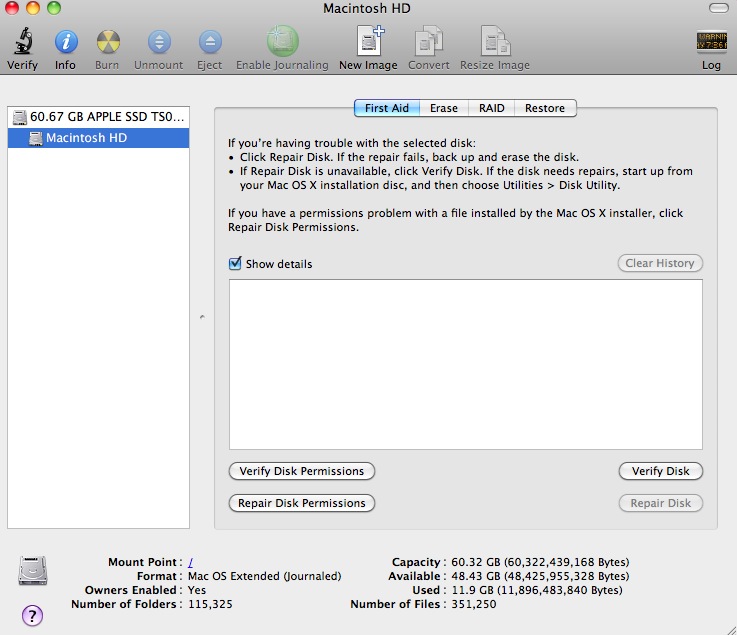
Thanks to my Time Machine backup on the Hackintosh desktop, I simply plugged in my backup drive to the MBA and some thirty minutes later I had imported the 28gB or so of Applications from the desktop, using Migration Assistant. After reinputting a couple of passwords for apps demanding same, I was up and running.
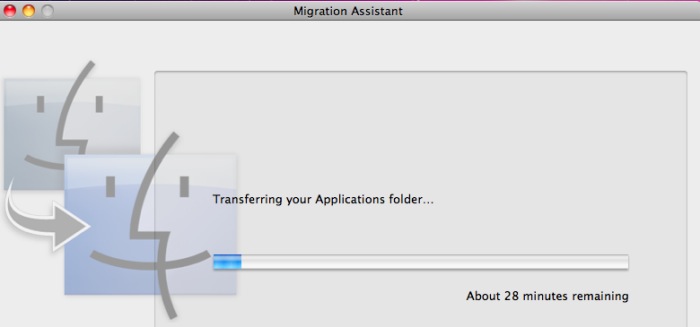
Overkill, sure, but I can always delete the apps I do not need on the MBA later. When all was said and done I had some 16gB of ‘disk’ space left in the MBA. That’s some 1200 RAW pictures from my Panasonic G1. Not bad for my purposes.
Next I ran the geeky tests – Geekbench and Cinebench which test CPU and GPU performance, respectively.
Geekbench, 64-bit comes in at 2205. For reference, the Intel Atom in my MSI Wind netbook, overclocked to 2gHz (1.6gHz is stock) reported a Geekbench (32-bit) score of 920.
And here’s Cinebench 64-bit:
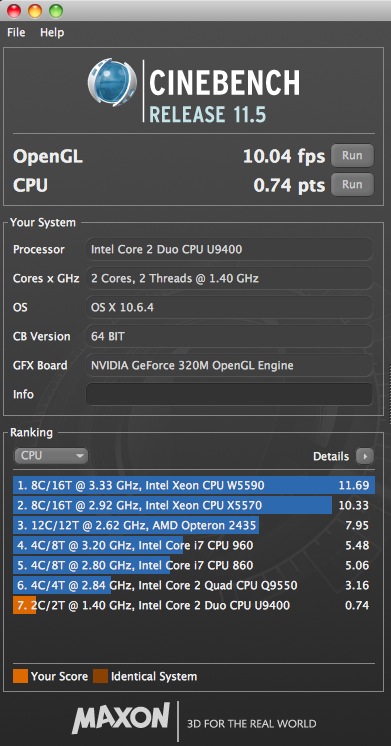
I never ran this test on my old netbook with the poky, integrated Intel GMA950 GPU. Life’s too short. My Hackro with the Intel Core2Quad and Nvidia 9800+ GPU is #6 in the above list. The fastest machines in that list are mostly using the latest Intel i3/i5/i7 and Xeon CPUs.
To compare this to my Core2Quad Hackpro desktop, which with dual displays weighs some 100 lbs more than the 2.3 lb. MBA, look here.
Sure, the Hackintosh blows the MBA away in every respect. Then again, you cannot stuff the Hackster in your shoulder bag. The MBA is no speed demon, but as I captioned this piece above, the MBA is a two seater sportster, not a truck. You want a truck, get a MacPro or build yourself a Hackintosh for one third of the cost.
Right after running these very stressful tests, I fired up Temperature Monitor, noticing that the MBA was getting warm on my lap. Not as uncomfortably warm as a MacBook or an iBook, but noticeably warm, though at no time did I hear the MBA’s single fan at work. Fan tests appear in Part V. I did not want TM running during the geek tests to limit CPU and GPU cycles to the testbench apps, so what you see below is the hottest the machine got after the high stress Cinebench test:
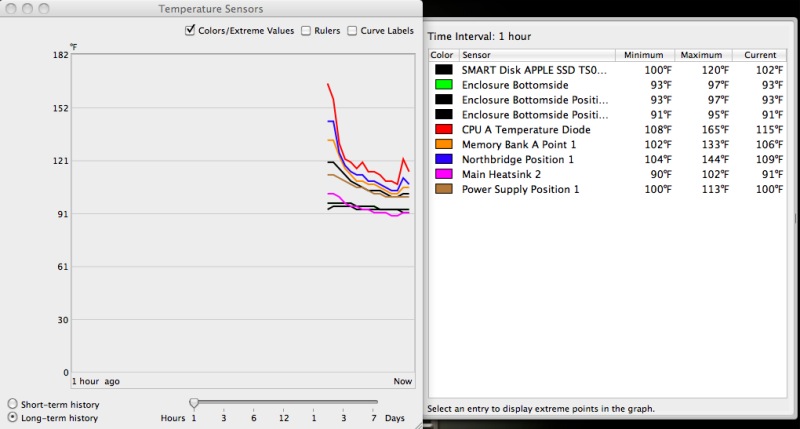
As you can see the CPU hit 165F. I’m unsure of the temperature limit for this low powered Core2Duo 1.4gHz CPU (Intel U9400) but suspect that there’s not much more than 20F headroom left after the Cinebench test. A bit close for comfort, confirming that heavy duty video processing is not the MBA’s forte. So the bottom of the case was noticeably warm on my lap even though there was no smell of burning epoxy in the air! However, the CPU dropped to 115F or so within the hour and has remained below that ever since. CInebench is a brutal CPU and GPU test. The CPU is at 99F as I write, the enclosure base at 86F (75F ambient temperature) and the MBA feels no different on my lap than the iPad. Meaning it’s cool, both calorically and aesthetically.
Maximizing disk space:
After doing a Time Machine restore of Applications from my HackPro I was left with some 16gB of space on the 60gB flash disk drive in the MBA. Many of these applications would never see use on the MBA but before I started erasing them I ran Omni Disk Sweeper to identify large files on the disk. You don’t want to erase any system files but applications typically reside in the Applications directory and often also in the Library->Applications Support directory. Look at the scan from Omni DIsk Sweeper, below, and you will see that Garage Band, which I will never use, takes up no less than 3gB in the latter directory, in addition to some 0.5gB in the Applications directory. So this tool provides a very efficient way of identifying the space hogs before deciding what to delete. After a few minutes work and after an Empty Trash command, my free disk space rose from 16 to 35gB!
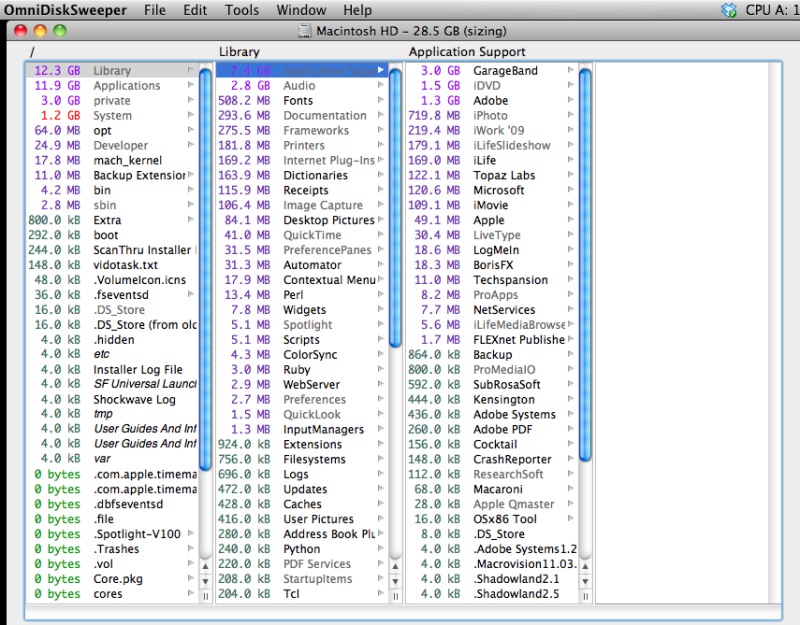
Photo processing tests will be addressed in Part III, but suffice it to say that Lightroom 3 (v 3.2) loads in 6-7 seconds. My clunky old Rosetta-powered PPC Photoshop CS2 loads in 45 seconds, about the same as on the HackPro. I’m rather optimistic about the MBA’s performance with RAW files in Lightroom, as the GPU (Nvidia GeForce 320M) is a decent one and Lightroom is very computer friendly, unlike Aperture which is a resource hog. Hey, it sells hardware!
More when I have profiled the screen properly and processed some pictures.
In the meanwhile, be assured this is a serious piece of hardware and, yes, Jobs is right. One day every laptop will be like this. And you can be assured that pulled punches have no place on this journal. Just read my experiences with Apple’s awful hardware.
Part III appears here.
Disclosure: Long AAPL common stock and AAPL call options.
Hi there,
Great write up. I was looking at one of these in the Apple Store in Sydney yesterday, and they are very very nice. I am really looking forward to you sharing your experience of Adobe Lightroom on the Air. I have a 17″ MBP i7 for heavy lifting, but I would love something really portable to rate / select / rename etc. shots in Lightroom during my commute.